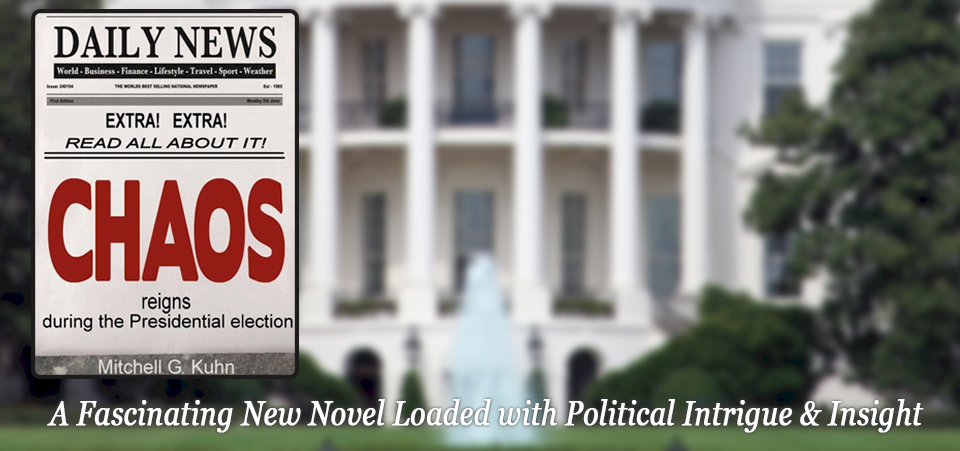Chaos reigns during the presidential election
a political novel by Mitchell G. Kuhn loaded with intrigue and insight

Chaos shines a laser at the heart of American politicians vying for the presidency. It exposes their intransigence, unyielding ideology, and inflated egos. Readers are brought into their inner sanctums, observing the maneuvering of the power brokers and witnessing firsthand how deals are made. Relationships and interactions between candidates and their supporters, as well as those among the candidates themselves, lead them into a cacophony of events whose consequences change the dynamics of our political system.
Chaos weaves an extraordinary tale of political intrigue and suspense that hits very close to home. Underhanded deals, surprising deaths, and disastrous party struggles—it’s just another day in the race for the presidency.
Read a sample
Part I, Chapter 1. Memphis Civic Center
South Carolina’s two-term Governor Peter Hasbrook, a 62-year-old married man with two children and three granddaughters, was unanimously chosen fifteen minutes ago by the delegates to the Republican National Convention as their nominee for the Office of President of the United States of America.
In the most unlikely of circumstances – and to the dismay of the political pundits and news media – Peter Hasbrook had no opposition for the nomination. Nor did anyone challenge him in any of the primary or State caucuses he entered. It was the most unusual, non-confrontational Presidential selection process the Republican Party had experienced in two hundred years. It brought back memories of Ronald Reagan’s coronation at his nominating convention for re-election in 1984.
His tall, athletic figure made an impressive image as he stood before an ecstatic, wildly cheering, placard-waving throng of twelve thousand Republican faithful in Memphis, Tennessee’s Civic Arena. Speaking without the use of a teleprompter, Governor Hasbrook addressed the delegates. He had been regaling the standing-room only masses for over forty-five minutes with his unique brand of folksy intellectual Americanisms. Never once did he invoke the name of the incumbent Democrat occupying the White House, nor did he criticize the policies of the woman that he and his Party hoped to defeat in the upcoming election.
Knowing his audience, he was careful to avoid bringing attention to unpopular positions he supported, which unfortunately were less than dear to the hearts of many delegates beholden to the philosophical right wing of his Party. No need, he reasoned, to create problems that could easily become controversial and erode his support among the Party faithful. They knew where he stood, and were aware of the boundaries he could not cross without incurring their wrath.
The crowd was waiting for him to reveal his Vice Presidential choice. That was the only thing left for him to do. The delegates knew it, the news media craved it, and his frustrated campaign staff demanded it.
He stopped talking for several moments, looked directly into the lens of the TV main camera, and then diverted his attention to the convention floor crammed with humanity. His head slowly moved left and right, back and forth, stopping to make direct eye contact with individual delegates as he took in the scene before him.
Raising his voice slightly, he said, “Guess y’all want to know who I’m going to ask to be my VP and who I’m hoping y’all will nominate as my running mate.”
Smiling sheepishly, he paused again and took a long sip of carbonated water from the glass sitting on the lectern. He put the glass back, and then raised his left hand high above his head to illustrate the stature of his selection. His right hand, now resting on to the podium, slipped, causing the Governor to lose his balance. He attempted to regain his footing by grabbing for the podium with his left hand. He missed, knocked over the glass, and fell to his knees.
The TV cameras froze, the delegates collectively gasped. In NBC’s control booth one hundred feet above the auditorium floor, John Franklin, program director, shouted directions into the headphones of the camera crew closest to the stage. “I don’t give a rat’s ass how you do it, but get as close as you can to Hasbrook! I want a closeup of his face and body.” But before his cameraman was able to reach the staircase on the side of the stage, a security guard blocked the way. Not so gently, he urged the crew back onto the convention floor.
The hall was devoid of air. All eyes were riveted on the giant video screens now showing Governor Hasbrook hunched over on all fours with a pained, glassy-eyed expression on his face, trying to rise onto his knees. Before any of the Secret Service men, staff, or dignitaries reached him, the Governor was already rising unsteadily to his feet. He turned to face the delegates. A restrained sigh of relief spread among them; a good number of them started clapping and cheering. That quickly subsided into another vacuum of silence when the Governor suddenly fell backward into the outstretched arms of the two Secret Service agents who had come to his aid.
